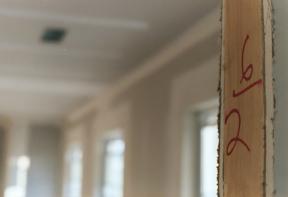Soundproof your garage or workshop
A little soundproofing can make your hobby a whole lot easier to live with
A friend of mine once made the mistake of complimenting his neighbour’s nightly drum practices. The sound of sticks hitting snares and cymbals rattled the apartment with all the force of a Black Sabbath concert–all the louder after the ill-conceived compliment. I get the feeling this is how some people feel about home workshoppers. Buzzing bandsaws and tablesaws make a racket, especially when the audience–your spouse, kids, neighbours–is bombarded with noise every time you step into the workshop.
“I didn’t bother soundproofing my old basement shop,” says Gord Graff, a woodworker in Newmarket, Ont. “Frankly, my wife and kids never complained because they got a house full of furniture. And that’s the bottom line: if you’re going to complain about my tablesaw making noise, then I won’t start it. And if I don’t start it, you won’t get that cherry hutch you want.”
Graff now builds in his garage shop, and whether he knows it or not, I bet his family is happy to be rid of the basement noise. But for those woodworkers who still work down under, there are ways to cut back on the racket. But before you start padding out walls with sound-dampening insulation, it’s useful to understand a bit about the science of sound.
Feel the vibrations
We can’t see sound, but you can think of it as a stream of air travelling along a path and seeking out leaks; if air can travel through something, so can sound. You can close doors and put up walls, but unless you interrupt its path, sound will move from room to room like shouts vibrating through paper-thin motel-room walls. Sound waves (vibrations) travel along the floor to the walls and ceiling. The vibrations continue through fasteners, joists and studs into adjoining rooms. This is why tin-can telephones work: so long as there’s a path–or string, in the case of a kiddie phone–sound can’t be stopped.
There are two types of sound: structure-borne noise (footsteps, slamming doors, the knocking of valves and pipes), which travels through walls and ceilings to create vibrations that travel through studs and other rigid joints; and airborne sound, which travels through the air before generating vibrations in walls, ceilings and windows (the buzz of power tools, voices, bass-driven music).
To deal with both types of sound, you need to do two things: absorb and block its path (structure-borne noise), and add mass and eliminate leaks (airborne sound).
“There are three elements to controlling sound: you have to block, break and absorb the sound,” says Andy Goyda, market development manager for Owens-Corning Canada, which manufactures noise-dampening batting and studs. “The most common mistake homeowners make is not thinking of walls and ceilings as a system. They think padding the ceiling will cut back on the noise; but they forget about the walls, and so the noise continues.”
Sound is measured in decibels (db), but for workshop purposes, sound transmission class (STC) is the most appropriate measurement. STC rates the minimum sound resistance of a floor, ceiling or wall; the greater the material’s STC, the better it will be at blocking or absorbing sound. A 24″ wall covered in 1/2″-thick drywall, for example, has an STC of about 30–not even enough to muffle your voice, let alone a thickness planer. And a standard basement ceiling, with exposed joists and subfloor, is even more transparent. “You might as well be woodworking underneath a bongo drum,” says Steve Maxwell, an expert woodworker and Canadian Home Workshop’s technical editor.
Jump to a section
To leave a comment, please log in












No comments